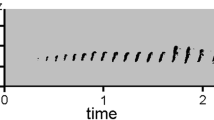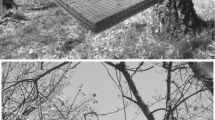Summary
Western meadowlarks (Sturnella neglecta) were played back female calls at various stages of their breeding cycles, to examine how residents might respond to unmated females. Females reacted to intruders with aggressive displays and other responses that varied in intensity (Table 1). Males reacted not only to playback, but also to their mates' responses, often intervening in them. The responses of both males and females, however, were strongly affected by the stage of the breeding cycle at which an intrusion was simulated (Table 3). Females responded to playback most strongly before they began incubating eggs; thereafter, the strength of their responses declined rapidly. Males' also responded less strongly at later stages of their mate's nesting cycle, but the strength of their responses declined less rapidly than did the females'. When the reactions evoked from mated individuals were compared, females responded at least as strongly as their mates, until after their young had fledged (Fig. 3). These seasonal changes in the intensity of females' responses suggest that decisions about how strongly to respond take account of the costs of responding to an intruder, as well as its benefits. Our results suggest that interactions among mated and unmated females may affect the timing of bigamy and, in some cases, its incidence as well.
Similar content being viewed by others
References
Altmann SA, Wagner SS, Lenington S (1977) Two models for the evolution of polygyny. Behav Ecol Sociobiol 2:397–410
Beletsky LD (1983) Aggressive and pair-bond maintenance songs of female red-winged blackbirds (Agelaius phoeniceus). Z Tierpsychol 62:47–54
Beletsky LD, Orians GH (1985) Nest associated vocalizations of female red-winged blackbirds. Z Tierpsychol 69:329–339
Bent AC (1958) Life histories of North American blackbirds, orioles, tanagers and allies. US Nat Mus Bull No 211
Dickinson TF, Falls JB, Kopachena JK (1987) Effects of female pairing status and timing of breeding on nesting productivity of western meadowlarks. Can J Zool 65:3093–3101
Dufty AM (1982) Response of brown-headed cowbirds to simulated conspecific intruders. Anim Behav 30:1043–1052
Emlen ST, Oring LW (1977) Ecology, sexual selection, and the evolution of mating systems. Science (Washington) 197:215–223
Falls JB, Horn AH, Dickinson TE (1988) How western meadowlarks classify their songs: evidence from song matching. Anim Behav 36:579–585
Horn HS (1968) The adaptive significance of colonial nesting in the Brewer's blackbird (Euphagus cyanocephalus). Ecology 49:682–694
Lanyon WE (1957) The comparative biology of meadowlarks (Sturnella) in Wisconsin. Publ Nuttall Ornithol Club 1:1–67
LaPrade HR, Graves HB (1982) Polygyny and female-female aggression in red-winged blackbirds (Agelaius phoeniceus). Am Nat 120:135–138
Leonard ML, Picman J (1987) Female settlement in marsh wrens: is it affected by other females. Behav Ecol Sociobiol 21:135–140
Nero RW (1956) A behavior study of the red-winged blackbird. I. Mating and nesting activities. Wilson Bull 68:4–37
Nero RW (1963) Comparative behavior of yellow-headed blackbirds, red-winged blackbrids, and other icterids. Wilson Bull 75:375–413
Orians GH (1969) The evolution of mating systems in birds and mammals. Am Nat 103:589–603
Orians GH, Christman GM (1968) A comparative study of the behavior of red-winged, tricolored, and yellow-headed blackbirds. Univ Calif Publ Zool 84:1–81
Roberts LB, Searcy WA (1988) Dominance relationships in harems of female red-winged blackbirds. Auk 105:89–96
Robinson SK (1985) Coloniality in the yellow-rumped cacique as a defense against nest predators. Auk 102:506–519
Saunders GB (1932) A taxonomic revision of the meadowlarks of the genus Sturnella Viellot and the natural history of the eastern meadowlark, Sturnella magna magna (Linnaeus). PhD thesis, Cornell University, Ithaca
Searcy WA (1986) Are female red-winged black brids territorial? Anim Behav 34:1381–1391
Siegel S (1956) Non-parametric statistics for the behavioral sciences. McGraw-Hill, New York
Verner J, Willson MF (1966) The influence of habitat on the mating systems of North American passerine birds. Ecology 47:143–147
Wiley RH (1976) Affiliation between the sexes of common grackles II Spatial and vocal coordination Z Tierpsychol 40:244–264
Wittenberger JF (1976) The ecological factors selecting for polygyny in altricial birds. Am Nat 110:779–799
Wittenberger JF (1979) The evolution of mating systems in birds and mammals. In: Marler P, Vandenbergh JG (eds) Social behavior and communication. Handbook of behavioral neurobiology, vol 3. Plenum Press, New York, pp 271–349
Wittenberger JF, Tilson RL (1980) The evolution of monogamy: hypotheses and evidence. Ann Rev Ecol Syst 11:197–232
Yasukawa K, Searcy WA (1981) Nesting synchrony and dispersion in red-winged blackbirds: is the harem competitive or cooperative? Auk 98:659–668
Yasukawa K, Searcy WA (1982) Aggression in female redwinged blackbirds: a strategy to ensure male parental investment. Behav Ecol Sociobiol 11:13–17
Author information
Authors and Affiliations
Rights and permissions
About this article
Cite this article
Dickinson, T.E., Falls, J.B. How western meadowlarks respond to simulated intrusions by unmated females. Behav Ecol Sociobiol 25, 217–225 (1989). https://doi.org/10.1007/BF00302921
Received:
Accepted:
Issue Date:
DOI: https://doi.org/10.1007/BF00302921




